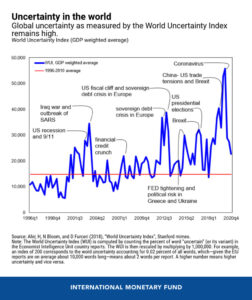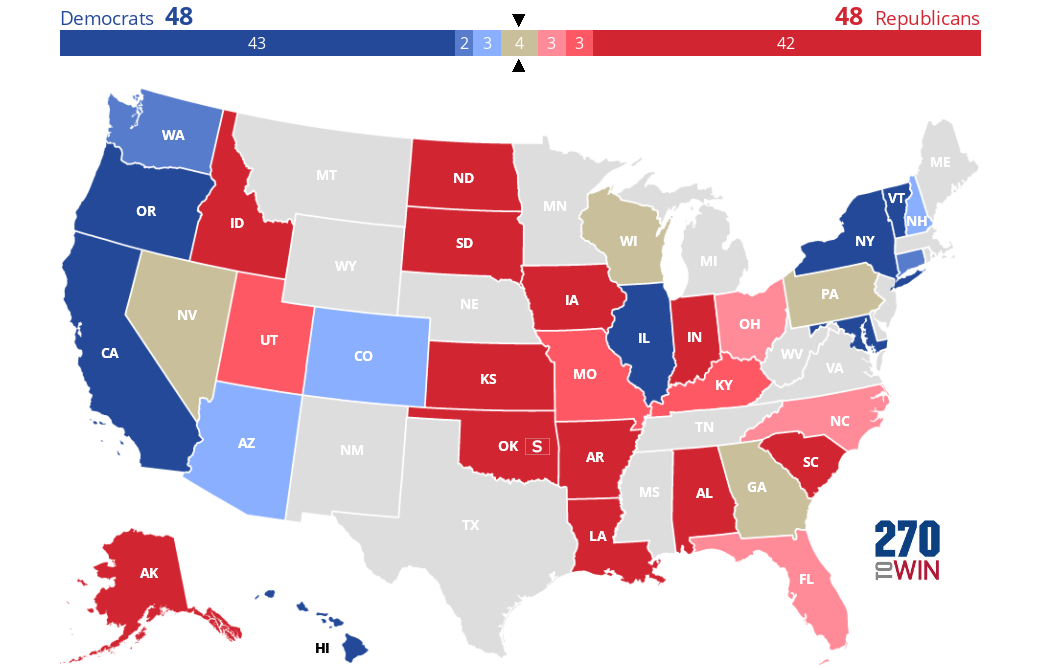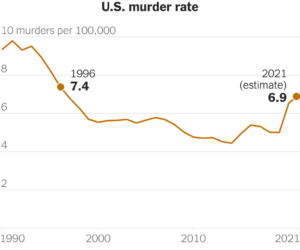To say that the upcoming 2022 midterm elections are historic is quite an understatement. With the rapid transformation of American politics such as increased political polarization, normalization of political violence, and culture wars, the past few years have seen ever-increasing tension over key issues like the teetering economy, border crisis, foreign policy, and handling of COVID-19.
Since his presidential victory in 2020, President Joe Biden has dealt with cataclysmic issues such as spikes in COVID-19 deaths, Russia’s invasion of Ukraine, and rising inflation that has harmed millions of Americans. Many analysts and pundits have predicted a washout Republican victory, as Biden’s popularity continues to sag. But in my opinion, there is a reason to believe that the Republicans, beset by extremely close Senate races, will fail to achieve the decisive rout of the Democrats that many expect.

The History of Midterm Elections and How They Work
The midterm elections are elections for members of Congress in between presidential elections. All members of the House of Representatives, made up of delegates from states based on population, are up for reelection every 2 years and thus are up for reelection during every midterm election. The Senate, made up of 100 Senators (2 for every state), only has around 35 of its legislature up for reelection every 2 years, because Senators serve 6-year terms.
The word “midterm elections” came from the fact that the midterms are held in between presidential elections and thus are in the “middle” of a President’s term of office. It should be noted that members of the Senate and House of Representatives are also up for election during regular presidential elections just like in the midterms.
Midterm elections are a long staple in American political history. In 1790, the first members of the American Congress were elected two years into President Washington’s first term. Thus began the unbroken cycle of 232 years of American legislative elections. Usually, the midterm elections occur between two rival political factions as America has nearly always possessed only two major political parties, which is rather unique considering the number of political parties in other countries like the United Kingdom or Germany.

Historically, the party of the incumbent President has performed poorly in midterm elections, because of a multitude of factors. Geoffrey Skelley and Nathaniel Rakich, both senior election analysts at FiveThirtyEight, an online website that discusses politics and public opinion polling, argued in an article that “these [factors] can largely be grouped into three categories: a midterm “reversion to the mean” after presidential elections, a “surge and decline” in voter turnout that changes the electorate from presidential years to midterm years and a broader “presidential penalty” where the party in the White House gets punished regardless of how the country is doing.”
These factors stem from one major proximate cause – the President that has recently been elected usually faces pushback and resistance from the opposing side, leading to losses in the midterm elections. These chances of defeat are exacerbated if the President is seen as particularly incompetent or hard times are befalling the nation, such as when Republicans flipped the House in 2010 as a result of conservative backlash towards President Barack Obama’s Affordable Care Act, economic slowdown as a result of the Great Recession, and budget deficits.

2022 Midterm Elections Prediction
As I’ve outlined the history of the midterm elections and the usual losses for the President’s party that comes with it, let’s look at the 2022 midterm elections. Incumbent President Joe Biden, who has had to deal with numerous crises throughout his 2 years as President of the United States, has been sagging in the polls.
FiveThirtyEight reports that Biden’s approval rating sits at 42.3%, meanwhile 51.9% disapprove the president. These numbers are about average for a president two years into his term, as Trump’s approval rating was also around 43% at this time in his presidency, and Obama’s was about 49%.
These numbers for Biden reflect some discontent amongst the majority of voters over two key issues.
First, high gas prices during the summer of 2022 placed a massive financial burden on American consumers. Although some of the blame belongs to Putin and pandemic-related supply chain shocks, Biden is still culpable for these issues.
Brad Pulombo, a policy correspondent at the Foundation for Economic Education, argues that “Biden has taken too many steps to count to limit domestic production. These include halting federal permits for oil and gas drilling and leasing shortly after taking office…that significantly affects gas prices.”
Another act that Biden did to raise gas prices was to impose complex rules and regulations on the energy sector, thereby raising the cost of production and transport of natural gas. George S. Van Nest, an environmental lawyer, argues that “[Biden’s] proposed rule that requires public companies to report on climate-related risks and emissions is being opposed by numerous Republicans…on the basis that it is overly complex and will merely add uncertainty and costs to corporations that are compelled to report on emissions.
President Biden’s actions have done virtually everything possible to limit the availability of domestic energy sources and increase the price of fuel,” Nest concluded.

Second, Biden’s mishandling of the inflation crisis has inflated the price of nearly every product imaginable, from food to lumber to machinery that will weigh heavily on who Americans choose to vote for in the midterm elections.
During COVID-19, the economic crash and subsequent business collapse across many sectors of the economy left millions of Americans newly unemployed. Former President Donald Trump and President Biden both passed bills that spent trillions of dollars in order to combat the crisis, including giving thousands of dollars to Americans in the form of stimulus checks, tax credits, and increased welfare.
Because of this increased financial assistance, Americans began to spend more money and demand exploded, just as the supply of goods faltered under the shutdown of much of the global economy. By early 2022, there simply were too few goods for too many people, leading to businesses raising prices on goods in order to prevent a complete sellout.
Biden’s decision to pass bills that pumped trillions into the economy, an economy that could not support the weight of the new capital, was foolish. Even Vice, a far-left online newspaper, asserted that “all [the legislation] came at the cost of making inflation worse. New Consumer Price Index numbers released Wednesday showed prices up 8.3 percent compared to one year before. And “core inflation,” which excludes volatile energy and food prices, rose 0.6 percent in just one month.
Countries around the world are struggling with inflation due to pandemic disruptions, but the Biden stimulus made the US’s inflation problem more severe, to at least some extent.”

The United States and much of the world are now facing severe economic uncertainty. The Brookings Institution, a world-renowned policy think tank, argued that “On both sides of the Atlantic, economies are showing signs of turmoil: Inflation is at the highest level in more than 40 years, the U.S. stock market has plunged significantly since its peak on January 3, and expectations for a recession are increasing both in the EU and in the U.S.”
The effects of Biden’s poor management of this crisis will sour his party’s chance for success in the elections. One analyst at the Brookings Institution claimed “The unpredicted and unwelcome return of rapid price increases has reshaped the political landscape with stark consequences for the Biden agenda. The American people now believe that inflation is the most important issue facing the economy and the country, and they don’t think that President Biden is paying attention to it. This explains why so many Americans disapprove of his economic performance—and why it is undermining his presidency.”
All in all, the vast majority of political pundits predict that Republicans will win the midterm elections, whether that means they will win the House of Representatives and Senate or just one of the two.
FiveThirtyEight believes that “Republicans are slightly favored to win the House.” RaceToTheWhiteHouse, another polling newsletter, also concurs, stating that Republicans will win the House of Representatives in the 2022 midterm elections.
Republicans themselves believe that the elections seem to be swinging in their favor, with the Washington Examiner quoting Republican campaign strategists as saying “Voters are still overwhelmingly pessimistic, more so than earlier this summer. President Biden’s numbers are still terrible. Inflation and the economy are still the most important issues for the majority of voters — especially independents, who still look more like Republicans than Democrats.”
Another Republican ad writer interviewed believes the movement toward the Democrats, “has plateaued.”
Republicans have high hopes for the elections, with expectations that they will sweep the house and claim the Senate by a narrow margin. This would possibly allow them to springboard into taking over the White House in the 2024 elections to take down Biden, who they feel would be easy prey given all of his recent popularity troubles.

I agree with this opinion, as it seems that Bidens seems to have dug himself into too deep of a hole to get out of. My prediction is that Republicans will win the House of Representatives but there’s a caveat:
Republicans will fail to achieve the decisive victory they seek by flipping the Senate, preventing a full-scale Republican wave in 2022. The Senate will remain a Democrat majority for the simple reason that most of the Senate races up for grabs will be extremely competitive with victory going either way. The few tossup races the Republicans can contest will, even in the best of scenarios, fail to yield Republicans the spectacular results they desire.
Not enough to scrape by
In midterm elections, candidates take center stage (literally) when it comes to determining election success or failure. Many different qualities affect the desirability of a candidate, whether it be their experience, charisma, marketing skills, and fundraising they may receive. Although a lackluster candidate can be propped up with lofty donations and an excellent campaign staff, who can carry them to victory, in tight races oratory skills or energy in a candidate can tip the scales.
Republicans seem to have strong candidates for their House of Representatives midterm races, and it seems that they’ll pick up a number of seats in Ohio, Minnesota, Nebraska, and Arizona, which are important states to pick up in preparation for the 2024 presidential elections. But in the Senate races the GOP seems to be struggling in fielding potent candidates to weigh against the Democrats, who are rallying to raise millions of dollars in funding to out-advertise their opponents.
Out of the 35 Senate Seats up for election in the midterms, 19 are expected to have Republicans voted in, but that leaves the other 16 seats up for grabs. Out of those 16, about 12 are expected to swing Democrat. That leaves 4 Senate seats – Wisconsin, Pennsylvania, Georgia, and Nevada open for grabs, ready to be taken either by the GOP or Democrats. Politico sees these 4 races as the most hotly contested of the entire midterm campaign – whoever takes these seats will likely have control over the Senate.
The problem with the Republicans’ situation here is that unless they wipe the floor with the Democrats – taking all 4 tossup races – then they will likely remain in a stalemate with Democrats in the Senate, with either a 50-50 split or an ever-so-minor Republican edge. The failure of the Republicans to attain a large majority over the Democrats in the Senate will mean the Democrats can still reject most legislation passed by the Republican-controlled Congress as they will retain a sizable minority.

I’ll be analyzing the 4 tossup races individually to check Let’s look at each of the 4 Senate races, and how the Republican candidates are doing.
First, we’ll start with the Georgia Senate Race. Democrat incumbent Raphael Warnock will be facing the up-and-coming Herschel Walker, a former college football player. Warnock seems to have the fundraising advantage over Walker, and also has the benefit of being more experienced, as Warnock has been a Senator for 2 years, whilst Walker has never run for political office.
Because of the lack of experience, Walker’s campaign hasn’t packed the firepower it needs to pull him through against Warnock’s strong defensive position. Ryan Mills, a political reporter for the National Review, described Walker as “charismatic and affable in person. He sprinkles his speeches with amusing stories, jokes, and Bible talk. He grew up poor and was bullied as a child because he was overweight and had a stutter. He turned himself into a football hero and, after retiring from the NFL, helped launch a poultry business and other ventures. Supporters who spoke with National Review appreciated his rural roots, his Christian faith, and his reputation as a hard worker.”
But Mills also notes that because of Walker’s inexperience and some worrying past events, he’s faced serious challenges throughout his campaign. “[Walker] was caught inflating his business and academic achievements and has made seemingly strange statements about climate change and pollution. Walker has focused his campaign on rising inflation, the worsening crime and border crises, and wokeness. He doesn’t offer much in policy prescriptions in his speeches, and his website is equally vague.
A history of domestic violence plagues him as well. His ex-wife once said, ‘He held a gun to my temple and said he was gonna blow my brains out.’ Walker acknowledges these allegations and says they stemmed from his well-publicized struggles with a dissociative identity disorder.”

Warnock isn’t free from criticism either, as he also was accused of “running over his wife’s foot with a car during an argument they had as he was trying to leave.” Warnock’s wife wasn’t injured during the incident, but he was attacked by GOP politicians over the affair.
Next, the Pennsylvania Senate races put former reality TV and surgeon Dr. Mehmet Oz vs Incumbent John Fetterman, current lieutenant governor of Pennsylvania. Although Oz has outspent Fetterman so far, he has suffered a chronic lack of support amongst GOP voters, many of whom see Oz as lacking conservative values.
Oz also has to face the fact that whilst 35% of Pennsylvania voters view him favorably, 55% don’t – in contrast to Fetterman’s better scoreboard of 49% viewing him favorably and 34% viewing him negatively. This puts Oz at a severe disadvantage when it comes to rallying voters.

The third race we’ll be examining is the Nevada Senate Race. This looks to be a better battleground for the Republicans, as the Republican Adam Laxalt with challenge incumbent Democrat Catherine Cortez Masto. Laxalt has gained a slight edge over Masto in recent weeks, due to rising discontent amongst Nevada voters on key issues. One newspaper commented that “the incumbent [is looking] particularly vulnerable due to rising crime rates and inflation.”
RealClearPolitics, an esteemed election prediction website, has predicted Laxalt to take Nevada. If this is true, then it would give Republicans a key senator who can help flip the Senate red, if Georgia, Pennsylvania, and Wisconsin go well.
Finally, the Wisconsin Senate race. Incumbent Republican senator Ron Johnson will be locking horns with his Democratic challenger, Mandela Barnes. This race, like Nevada, seems to be leading in the Republicans’ favor ever so slightly. The deciding factor in this race appears to be over “rising crime which has become a major issue in the campaign for both sides,” as a reporter for NPR commented.
Many Wisconsin voters however seem to be concerned that both Johnson and Barnes are too extreme in their positions, and the Hill notes that there appears to be flagging enthusiasm amongst both candidates, with 56% of Johnson voters describing themselves as enthusiastic compared to 50% of Barnes voters. Overall, it seems that Republican Johnson has a slight edge just as Laxalt possesses an advantage over Masto in the Nevada Senate elections.

Conclusion
It seems that although many argue that a reckoning of the Republicans will spell doom for Democrats in November, it seems that the likely outcome is a marginal but tempered Republican victory that falls short of expectations. Democrats will probably see defeat at some level in the midterms, although the severity of this loss is uncertain.
The Republican nominee in Nevada and incumbent in Wisconsin are likely to pull through in victories over their Democratic opponents, whilst a lack of experience and fundraising puts Herschel Walker behind Warnock in the race for the Georgia senate election. In Pennsylvania, the state of the race is far more contentious due to a narrowing in public polls of both Dr. Oz and Lt. Gov. Fetterman.
Overall, it seems Republicans have a narrow shot of taking the U.S Senate by one or more seats in the 2022 midterm elections, giving them a painstakingly narrow 51-49 or 52-48 majority. This technically would put the Republicans in the majority in Congress but would not be the massive “red wave” that some predict. Finally, it should be noted that nothing is certain, especially during an election cycle.

